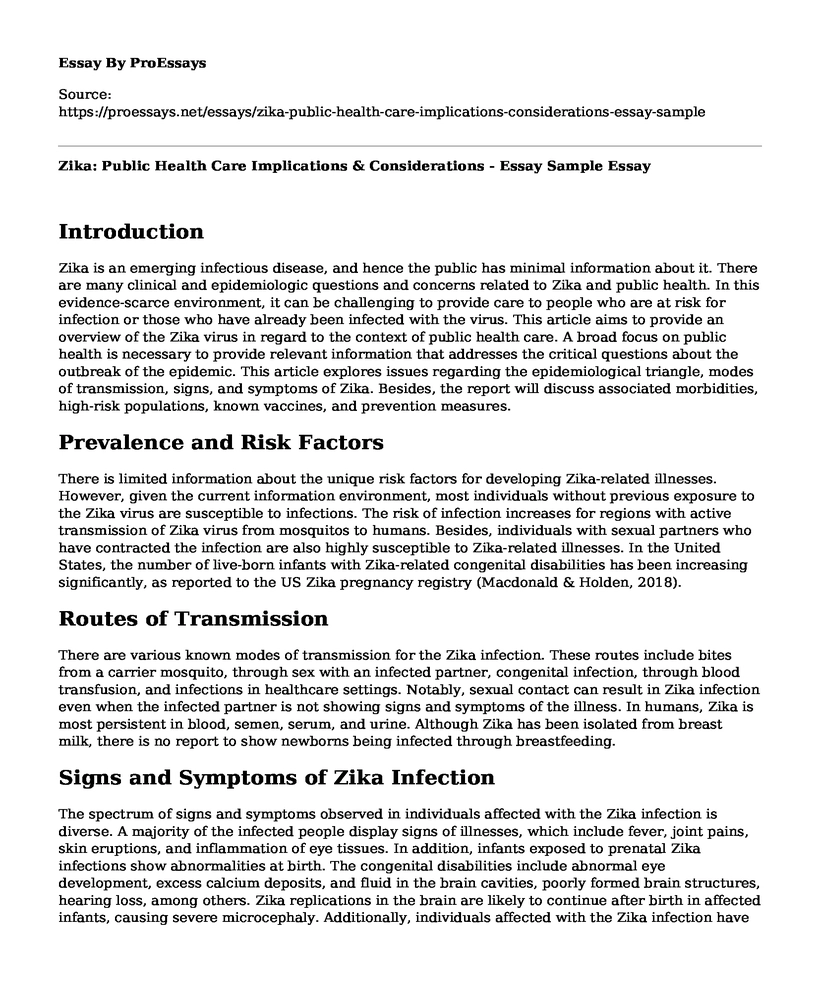Introduction
Zika is an emerging infectious disease, and hence the public has minimal information about it. There are many clinical and epidemiologic questions and concerns related to Zika and public health. In this evidence-scarce environment, it can be challenging to provide care to people who are at risk for infection or those who have already been infected with the virus. This article aims to provide an overview of the Zika virus in regard to the context of public health care. A broad focus on public health is necessary to provide relevant information that addresses the critical questions about the outbreak of the epidemic. This article explores issues regarding the epidemiological triangle, modes of transmission, signs, and symptoms of Zika. Besides, the report will discuss associated morbidities, high-risk populations, known vaccines, and prevention measures.
Prevalence and Risk Factors
There is limited information about the unique risk factors for developing Zika-related illnesses. However, given the current information environment, most individuals without previous exposure to the Zika virus are susceptible to infections. The risk of infection increases for regions with active transmission of Zika virus from mosquitos to humans. Besides, individuals with sexual partners who have contracted the infection are also highly susceptible to Zika-related illnesses. In the United States, the number of live-born infants with Zika-related congenital disabilities has been increasing significantly, as reported to the US Zika pregnancy registry (Macdonald & Holden, 2018).
Routes of Transmission
There are various known modes of transmission for the Zika infection. These routes include bites from a carrier mosquito, through sex with an infected partner, congenital infection, through blood transfusion, and infections in healthcare settings. Notably, sexual contact can result in Zika infection even when the infected partner is not showing signs and symptoms of the illness. In humans, Zika is most persistent in blood, semen, serum, and urine. Although Zika has been isolated from breast milk, there is no report to show newborns being infected through breastfeeding.
Signs and Symptoms of Zika Infection
The spectrum of signs and symptoms observed in individuals affected with the Zika infection is diverse. A majority of the infected people display signs of illnesses, which include fever, joint pains, skin eruptions, and inflammation of eye tissues. In addition, infants exposed to prenatal Zika infections show abnormalities at birth. The congenital disabilities include abnormal eye development, excess calcium deposits, and fluid in the brain cavities, poorly formed brain structures, hearing loss, among others. Zika replications in the brain are likely to continue after birth in affected infants, causing severe microcephaly. Additionally, individuals affected with the Zika infection have shown signs of Guillain-Barre syndrome (GBS) (Macdonald & Holden, 2018).
Prevention
Currently, there are no known vaccines for Zika infection. However, taking personal measures and initiatives can help to reduce the risk of acquiring Zika-related illnesses. Personal measures, such as condom use, can inhibit the transmission of Zika infection through sexual contact. Other measures such as the use of mosquito repellants, windscreens, sleeping under treated mosquito nets can help to reduce the risk of mosquito bites in areas where local transmission of Zika virus is prevalent.
Conclusion
In summary, Zika is an emerging infectious disease that is spreading to new populations and geographic areas. However, it is challenging to estimate the real incidence of Zika infection due to variations in disease-reporting practices globally. The challenge is further exacerbated since only a few numbers of the infected people are symptomatic. A lot needs to be done to enhance the public's knowledge about Zika-related infections.
References
Macdonald D.M. & Holden, W.E. (2018). Zika and Public Health: Understanding the Epidemiology and Information Environment. Retrieved from https://pediatrics.aappublications.org/content/141/Supplement_2/S137
Cite this page
Zika: Public Health Care Implications & Considerations - Essay Sample. (2023, May 02). Retrieved from https://proessays.net/essays/zika-public-health-care-implications-considerations-essay-sample
If you are the original author of this essay and no longer wish to have it published on the ProEssays website, please click below to request its removal:
- Paper Example on Infectious Diseases
- Essay on Negative Culture Plagues Medical-Surgical Units: Impact on Nurses
- Essay Sample on Christiaan Barnard: World's First Human-to-Human Heart Transplant Pioneer
- Rising Pharmaceutical Prices: A Cause for Concern - Essay Sample
- Free Essay Sample on NYC Schools Reopen: Complex Logistics & Uncertainty
- Reducing Ventilator Infections: Establishing Intents for the Capstone Project - Paper Sample
- Free Paper Example: Perioperative Service Enhancement







